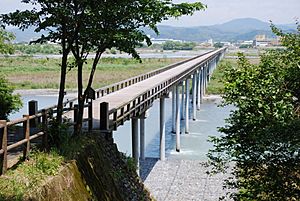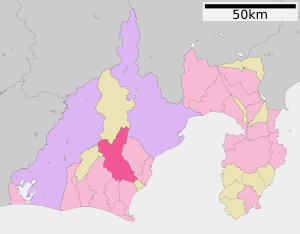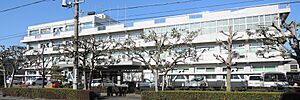Shimada, Shizuoka facts for kids
Quick facts for kids
Shimada
島田市
|
|||
|---|---|---|---|

Hōrai Bridge in Shimada
|
|||
|
|||

Location of Shimada in Shizuoka Prefecture
|
|||
| Country | Japan | ||
| Region | Chūbu (Tōkai) | ||
| Prefecture | Shizuoka | ||
| Area | |||
| • Total | 315.70 km2 (121.89 sq mi) | ||
| Population
(September 2023)
|
|||
| • Total | 93,724 | ||
| • Density | 296.877/km2 (768.907/sq mi) | ||
| Time zone | UTC+9 (Japan Standard Time) | ||
| Symbols | |||
| • Tree | Osmanthus | ||
| • Flowers | Rose, azalea | ||
| • Bird | Blue-and-white flycatcher | ||
| Phone number | 0547-37-8200 | ||
| Address | 1-1 Chūō-chō, Shimada-shi, Shizuoka-ken 427-8501 | ||
Shimada (島田市, Shimada-shi) is a city in Shizuoka Prefecture, Japan. It covers an area of about 315.7 square kilometers (121.9 square miles). In September 2023, about 93,724 people lived there. This means there were about 300 people per square kilometer.
Contents
Geography and Climate
Shimada is in the Shida Plains, in the western part of Shizuoka Prefecture. The Ōi River flows through the city. Shimada has a warm maritime climate. This means it has hot, humid summers and mild, cool winters.
Neighboring Cities and Towns
Shimada is surrounded by several other places in Shizuoka Prefecture. These include cities like Fujieda and Kakegawa. It also borders towns like Yoshida.
Population Changes
The number of people living in Shimada has stayed mostly the same over the last 50 years.
| Historical population | ||
|---|---|---|
| Year | Pop. | ±% |
| 1940 | 68,753 | — |
| 1950 | 86,704 | +26.1% |
| 1960 | 94,272 | +8.7% |
| 1970 | 96,613 | +2.5% |
| 1980 | 100,519 | +4.0% |
| 1990 | 103,149 | +2.6% |
| 2000 | 102,585 | −0.5% |
| 2010 | 100,250 | −2.3% |
The average yearly temperature in Shimada is 15.7 °C (60.3 °F). The city gets a lot of rain, about 2142 mm (84 inches) each year. September is usually the wettest month. August is the hottest month, with temperatures around 26.5 °C (79.7 °F). January is the coldest, at about 5.2 °C (41.4 °F).
History of Shimada
Shimada has a long history. It started as a small fort during the Sengoku period (a time of war in Japan). This fort helped control the crossing of the Ōi River.
Post Towns and the Ōi River
During the Edo period (1603-1868), Shimada and Kanaya became important "post towns" (shukuba). These were places where travelers could rest along the Tōkaidō highway. This road connected the old capital, Kyoto, with Edo (modern-day Tokyo).
The government at the time, the Tokugawa shogunate, did not allow bridges or ferries on the Ōi River. This was to make it harder for enemies to cross. Travelers often had to wait days or weeks in Shimada or Kanaya for the river water to go down.
Modern Times and the Hōrai Bridge
After the Meiji Restoration in 1868, Japan changed a lot. In 1879, the first bridge, the Hōrai Bridge, was built across the Ōi River. This bridge connected Shimada and Kanaya.
In 1889, Shimada and Kanaya became modern towns. On April 16, 1889, a railway line opened, connecting the two towns. Shimada became a city on January 1, 1948. Over the years, it grew by joining with nearby villages and towns.
In 2012, Shimada helped with cleanup efforts after the 2011 Tōhoku earthquake and tsunami. It was one of the first cities outside the disaster area to accept debris for disposal.
Economy and Jobs
Shimada's economy is mainly based on farming. Green tea is the most important crop grown here. There are also some light industries in Shimada. These include factories that make parts for cars.
Education in Shimada
Shimada has many schools for children and teenagers. There are 18 public elementary schools and seven public middle schools. The city also has one middle school run by the national government. For older students, there are four public high schools and one private high school. There is also a special education school for students with disabilities.
Getting Around Shimada
Shimada has good transportation links.
Trains
- Central Japan Railway Company - Tōkaidō Main Line
- Rokugo - Shimada- Kanaya
- Ōigawa Railway Ōigawa Main Line
- Kanaya • Shin-Kanaya • Daikanchō • Higiri • Gōkaku • Kadode • Kamio • Fukuyō • Owada • Ieyama • Nukuri • Kawaneonsen-Sasamado
Highways
 Tōmei Expressway
Tōmei Expressway Shin-Tōmei Expressway
Shin-Tōmei Expressway National Route 1
National Route 1 National Route 473
National Route 473
Airport
- Shizuoka Airport is also nearby.
International Connections
Shimada has special connections with other cities around the world. These are called "sister cities."
 Brienz, Switzerland (since 1996)
Brienz, Switzerland (since 1996) Himi, Toyama, Japan (since 1987)
Himi, Toyama, Japan (since 1987) Huzhou, Zhejiang, China (since 1987)
Huzhou, Zhejiang, China (since 1987) Richmond, California, United States (since 1961). Students from Shimada and Richmond often visit each other through an exchange program.
Richmond, California, United States (since 1961). Students from Shimada and Richmond often visit each other through an exchange program.
Fun Places to Visit
- Hōrai Bridge: This famous bridge is very long and has a lot of history.
- Ōigawa Railway: You can ride old-fashioned steam trains here.
- Suwahara Castle ruins: These are the remains of an old castle, now a national historic site.
Famous People from Shimada
Many talented people come from Shimada, including:
- Masafumi Gotō, a musician
- Horiyoshi III, a famous tattoo artist
- Kayoko Kishimoto, an actress
- Hokuto Matsumura, a member of the idol group SixTONES
- Minato Oike, a BMX freestyle cyclist
See also
 In Spanish: Shimada para niños
In Spanish: Shimada para niños





